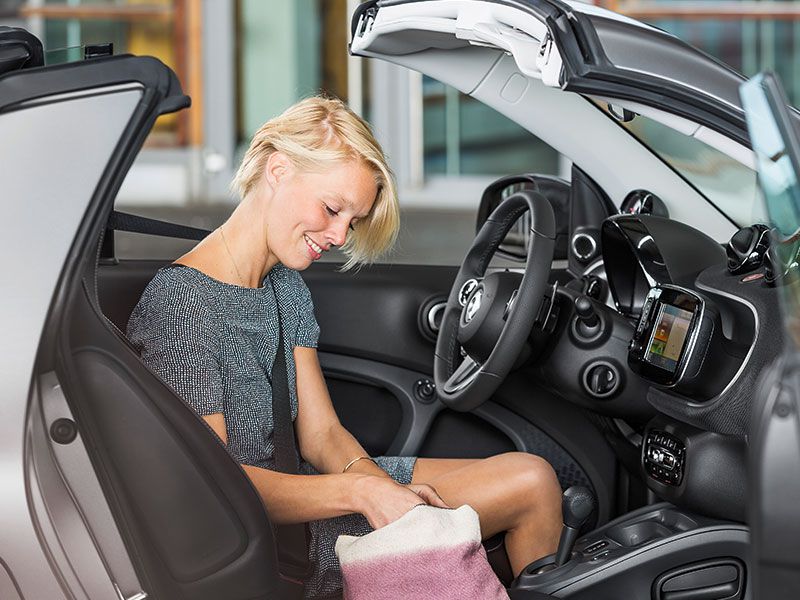Recent Articles
Popular Makes
Body Types
10 Things You Should Know About the Smart ForTwo Cabriolet
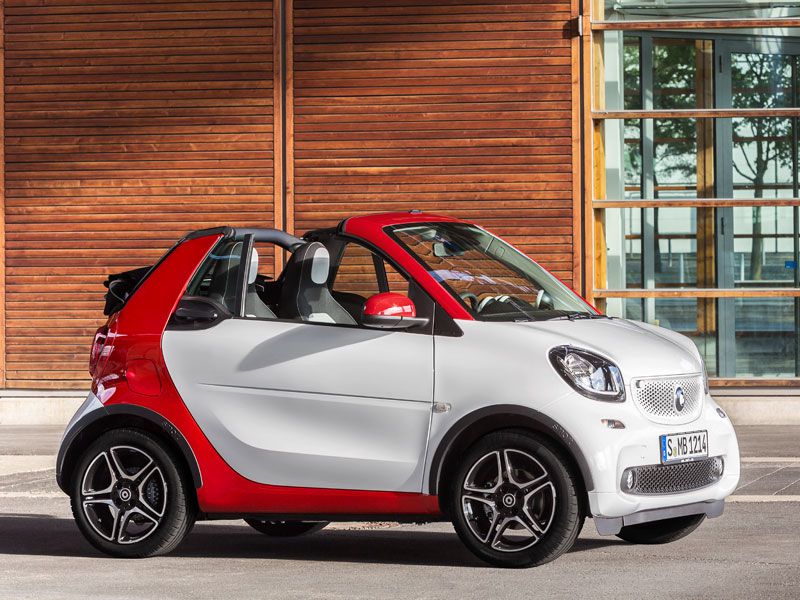
2017 smart fortwo cabriolet
Depending on your outlook on life, Smart’s diminutive ForTwo is either “cute and sporty” or looks like “Shaq’s high-tops with wheels.” Smart cars have always been highly polarizing vehicles, in the very same—but inverted—way in which Hummer’s H2 caused both chrome-wheeled devotion and virulent hatred in the early aughts. And this drama has always been reflected in American sales: while Smart sells plenty in Europe, they have never quite caught on in America. Primarily because we have more space, and secondarily because we like our things BIG.
But there are places in America where space is at a premium, and it is in these tight pockets of urban living where the Smart ForTwo—both in Coupe and droptop Cabriolet form—makes a lot of sense. Because sometimes a vehicle is good despite being small, and other times it’s good precisely because it is small. Ease of parking in congested city environments, a relatively thin body that can squeeze through minute gaps in traffic, a small wheelbase that allows the car to pirouette at stop signs—if you’ve ever enjoyed a car with these attributes, then you know a pocket-sized footprint is an asset, not a detriment.
To experience the vehicles on both freeways and open boulevards, Smart invited a handful of journalists to drive their droptop ForTwo Cabriolet to Palm Springs on Coachella weekend. The reactions from the swarms of young passersby was almost universally positive, so the car does seem to resonate with the millennial set—that much is clear. Available in four trims (Pure, Passion, Prime and Proxy), we were only offered Primes for the trip but that does seem to be the sweet spot in the value/features department. After four days driving the convertible around the Desert Cities, these are the 10 Things We Learned About the Smartcar Cabrio.
Totally New, Much Improved Transmission
When the first Smart car arrived on American shores in 2008 (actually the second generation of the ForTwo), one of the reasons it was so poorly received was its awkward single-clutch manumatic transmission. While Europeans are well versed in automated manual trannies, Americans understandably found it clunky, loud, and unacceptably slow. Now for 2017, Smart has thrown out that cursed manumatic and replaced it with two options. The first is a smooth, quick-shifting 6-speed dual clutch (DCT) “Twinamic” system that drastically improves the ForTwo in every way. In comfort terms, the experience is like switching from heavy, misshaped work boots to top-of-the-line performance sneakers. Not only does the Twinamic improve shifting and acceleration, but it elevates the entire holistic driving experience. Throw on paddle shifters with the optional Sport Pack, and you gain an even sportier experience. With the push of a button you can switch from “Eco” to “Sport” mode and raise its shift points, holding gears a little bit longer for an added burst of acceleration.
“The transmission issue was definitely something we heard. We knew that a solution called for more than an automated manual,” Keith Edwards, Assistant Product Manager of the smart coupe and Cabrio, told me. “We’re very, very happy with the results.”
Although the DCT is optional, the standard transmission is a 5-speed manual that offers enthusiasts more control over their vehicle. We didn’t have a chance to drive the manual on our journey, but wish we had. Fun fact: the Smart is now the only Daimler / Mercedes-Benz vehicle you can buy in the States with a stickshift.
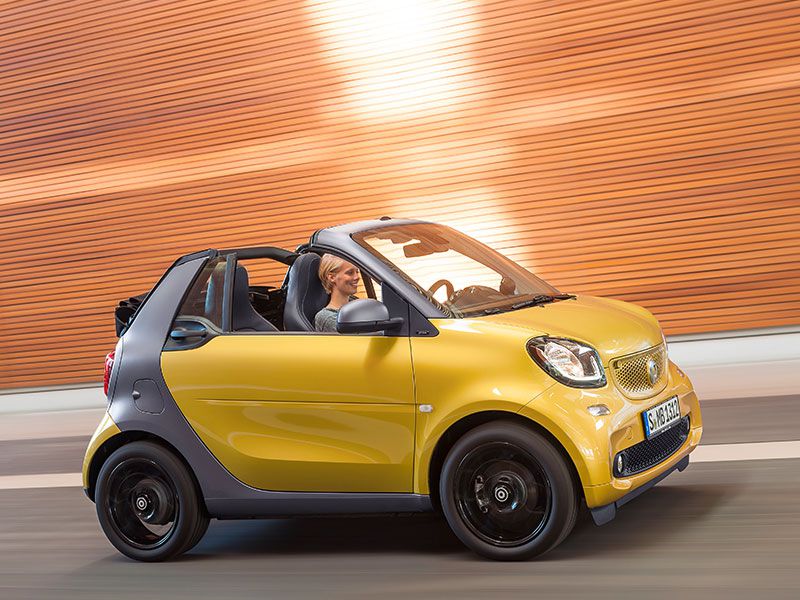
Better Engine, Too.
Not only was the new Twinamic transmission developed exclusively for the third-gen Smart ForTwo, but the entire powertrain is unique to the brand. The 898cc three-cylinder turbo engine is not found on any other Daimler product, and was developed from the ground up expressly for these cars. While its output is modest for the modern market (89 horsepower and 100 lb.-ft of torque), the diminutive powerplant boasts a superb 100-hp/liter ratio. Constructed of lightweight aluminum, the engine offers plenty of low-end push for such a tiny car (about 2,000 lbs): you can hit 0-60 in 10.1 seconds in the Coupe, and 10.7 seconds in the Cabrio.
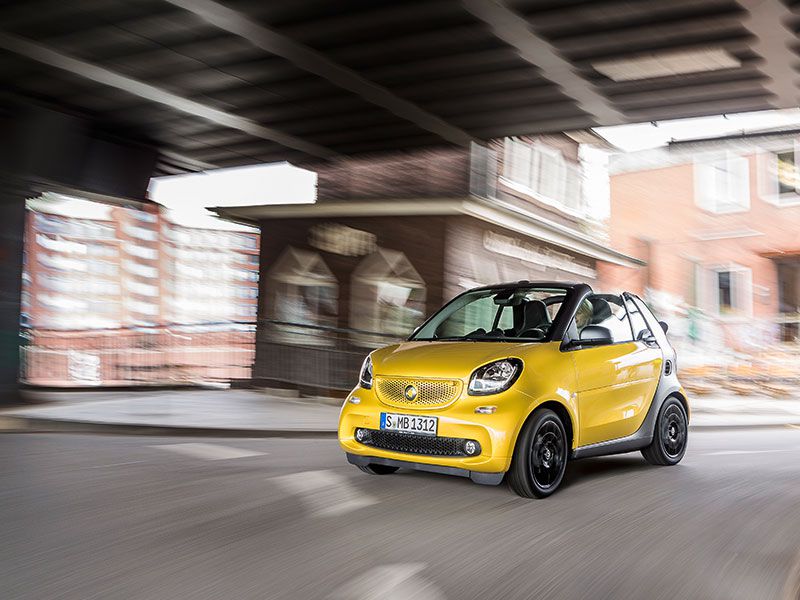
Same Length, But Noticeably Roomier
While the 2017 Smart ForTwo Cabrio has the same height and length (8.8 feet) as the outgoing model, it is almost four inches wider. This girth expansion is most noticeable on the inside, where both elbow and shoulder room have increased. In the last model, the space was so tight that the passenger seat had to be staggered just a bit behind the driver seat, but now the room is sufficient so they can be aligned parallel to one other.
Inside, there’s all sorts of devils in the details like a recurring honeycomb motif found throughout the car (it's a reference to the car’s safety features, as the honeycomb is the strongest shape in nature). There’s an optional touchscreen across the line, and an SD card for music and maps. The highest Proxy trim level comes with a brilliant white and electric blue leather interior, with aluminum pedals and rubber studs.
Fittingly, the exterior is also improved all around. While all generations of Smart ForTwos have a similar overall aesthetic, the 2017 model looks much bulkier and more solid, with more road presence. Every composite plastic body panel has been completely redesigned; there’s not a single panel shared with the older model. The dent-resistant construction is ideal for inner city driving, where the hazards of commuting in tight space (not to mention parallel parking) can result in bangs and bruises.
The Cabrio also features standard LED running lights, and an upgraded lighting package includes a more fluid headlight design and taillights with eleven LED rhombic cubes. Fog lights with cornering function also come with the lighting package (the lights pivot in the direction you’re turning to illuminate your path). This lighting package comes standard with the Prime and Proxy trim levels.
An optional Sport package throws on chrome exhaust tips, black 8-spoke 16" wheels, paddle shifters and a sport steering wheel. The sport suspension lowers the car by 10 mm, giving it a bit more presence and further stiffening up the ride.
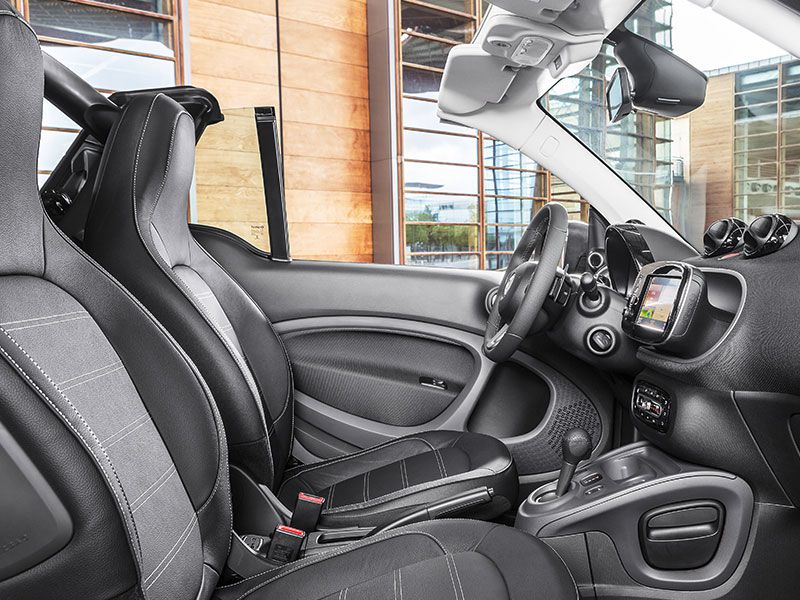
Most Affordable Convertible You Can Buy
While pricing is still not known, Smart execs have promised that the Cabrio will be the least expensive new convertible available when it hits the marketplace in early summer. Unlike the FIAT 500C, whose roof runs along a track that never disappears, the Cabrio is a true convertible—because of its removable roof bars (which can be stored in the trunk), the Cabrio offers 100% open-top motoring.
And you can lower or raise the top at speeds up to 80 mph; it will fully close in 12 seconds. (Actually, you can drop or raise the roof up to its top speed of 94 mph, but it’s not recommended.) With a 2-stage operation, you press the button once and the cloth top gives you a Targa-like halfway option. Press it again and it goes all the way down.
The Cabriolet weighs only 44 pounds more than the Coupe, mostly due to reinforcement on the A-pillar for safety and rigidity. Should you tick the matte paint option, you will also be getting the cheapest matte exterior available in the market.
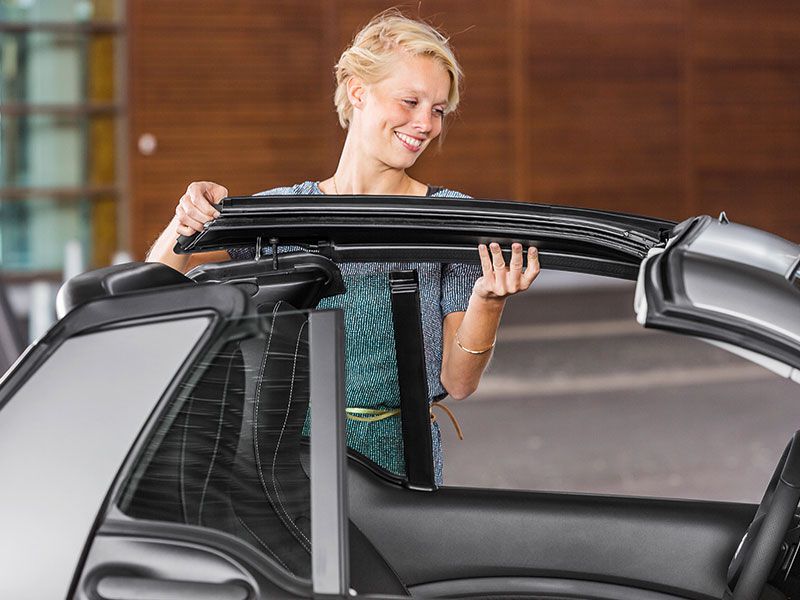
Turn On a Dime. Almost.
Because the Smart ForTwo was made wider in the new generation, the extra room allowed engineers to pull the wheels closer into the wheel wells. This means that even though the car is larger than its predecessor, it turns even more quickly. How well? Try an eyebrow-raising 22.8-foot turning circle. What this means is you can pull a complete U-turn on a one-lane road. While taking photos we drove the Cabrio up a steep hill, and had to turn it around in a very tight space. We accomplished the 180 without ever putting the car in reverse. You can imagine how handy this will be in the West Village.
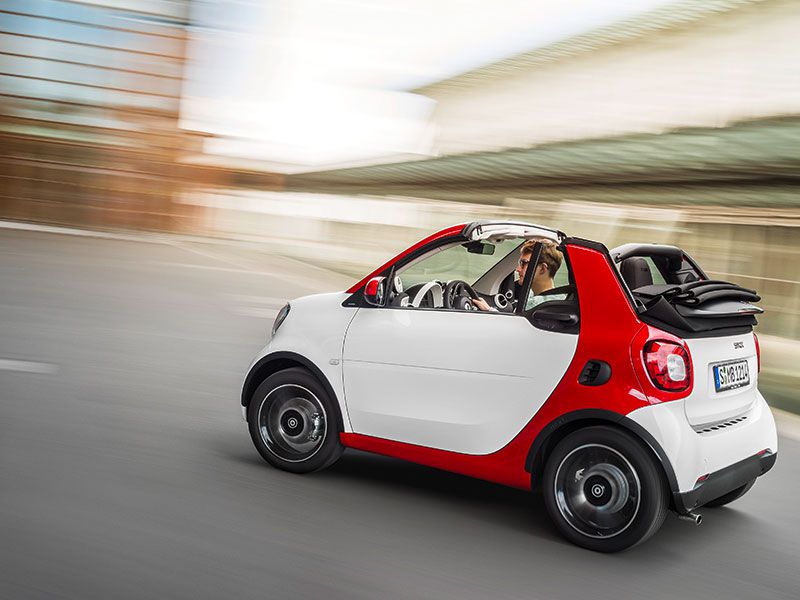
Photo by Mercedes-Benz Media
Exceptional JBL Soundsystem
If music is at a premium in your household, then tick the option for the available premium JBL soundsystem. The 200-watt system comes with a 5-channel amplifier and 6 speakers (8 speakers for the Coupe). But the most innovative aspect of the JBL system is the removable subwoofer in the trunk—the only one like it in a production car. Lots of thought went into maximizing cargo area. To optimize the best use of space, engineers at JBL designed the subwoofer so it could be easily removed with a pull latch should you need the extra room.
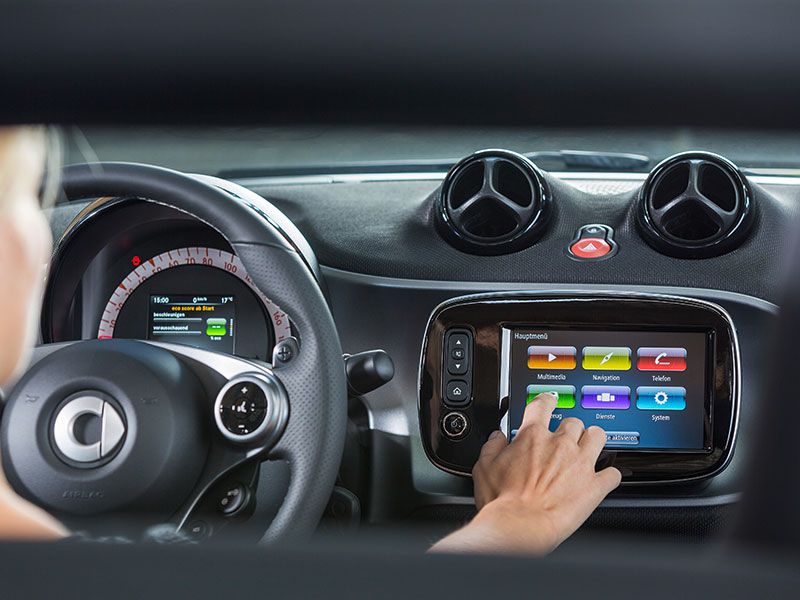
Drives Surprisingly Well, If Not Underpowered
Even though much of our ride was on the open 10 Freeway and not tiny city streets, the Smart Cabrio was a relaxed highway cruiser. Its zippy engine offered bursts of passing speed, but it plateaued around 80 mph (we never felt like pushing it much faster than that). With the top up there was wind noise, but it never interfered with our ability to converse. The Smart has nice greenhouse visibility from the front and sides, although the large B-pillars make rear viewing very tight. You can also raise the height of the seat so the seating position feels quite high, almost like a CUV. And once we got off the freeway and drove it on sunny Palm Springs boulevards, the Cabrio offered a very pleasant open-air motoring experience: sufficiently quiet, peppy, rear-wheel-drive fun with superb tight-space agility.
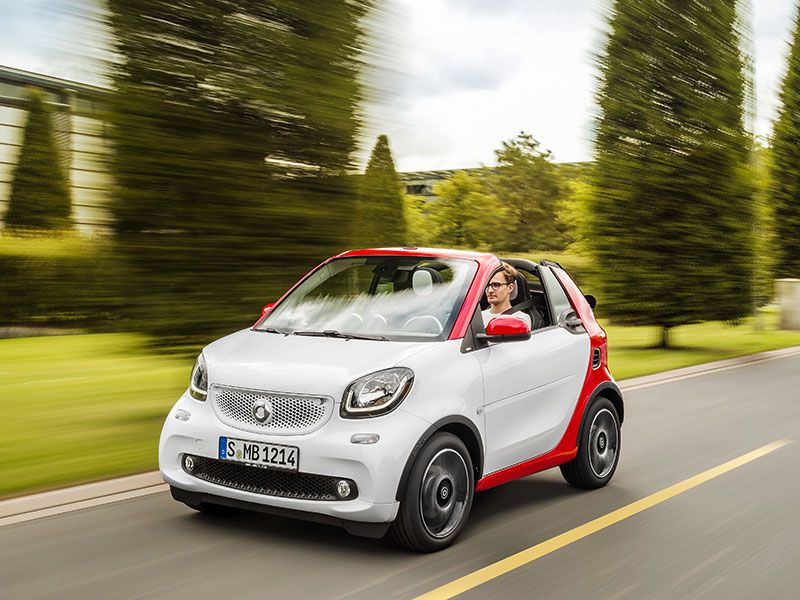
Photo by Mercedes-Benz
Safety Is a Big Concern
One of the most impressive advancements Smart made was to improve the previous model’s patented Tridion safety cell construction. The Tridion cell uses high-strength multiphase steel (HSS) to form a protective shell around passengers, and the new model uses 75-percent of the material in the construction of the vehicle (versus the outgoing model’s 47-percent HSS). Torsional strength was therefore improved by 15-percent. Combined with the Cabrio’s 6 airbags (8 for the Coupe), you have a tiny car that passes all the stringent crash tests that every single Mercedes-Benz must survive. They even drop the Cabrio upside down onto the A-pillar; an online video shows the Coupe crashing into the gargantuan Mercedes S-Class flagship sedan, and its Tridion cage stays solid. Daimler holds rigorous internal standards for safety, and the fact that the Smart Cabrio passes them all should be reassuring.
There’s also Forward Collision Warning (when the car senses a possible collision, it offers a visual then audio alert), Electronic Stability Control and ABS brakes. One more note on the patented Tridion cell: a new cutout at the foot level allows for easier ingress and egress from the car.
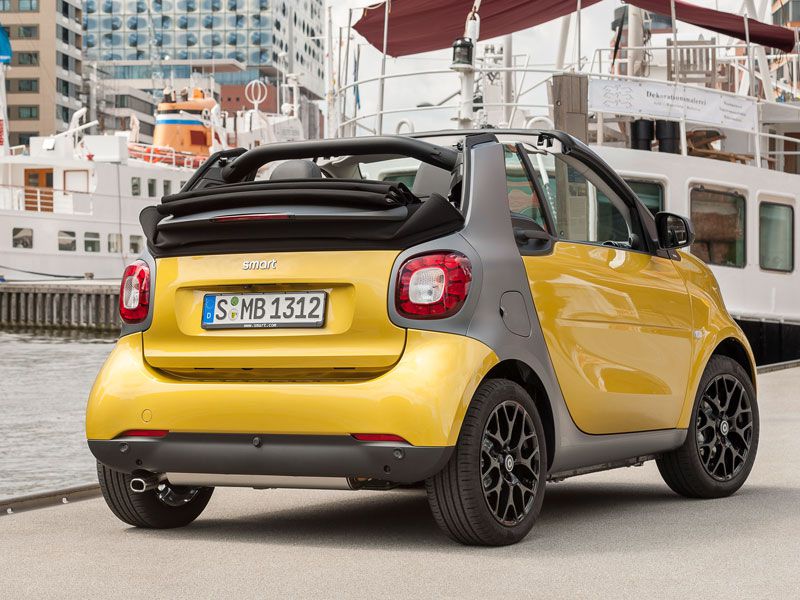
Borrows Crosswind Assist From the Sprinter Van
Smart borrows a tech called Crosswind Assist from their Sprinter cousins. Fitting, as both of these vehicles share a slab-walled design that is more vertical than wide. Crosswind Assist works by braking whatever wheels are closer to the direction from where the wind is coming in order to keep the Cabrio directionally sound. While this is solid tech, we hit violent winds outside of Palm Springs that were so strong that the Smart was still pushed sideways (to be fair, they were so strong there was a wind advisory).
Other standard tech includes cruise control, Bluetooth for hands-free talking, power windows, cruise control, hill start assist and an automatic climate control with a very cool, unique slider that magnifies the temp as you slide it horizontally. There’s also an app called Cross Connect with some fun wizardry. Once mounted on a cradle that sits in front of the radio, your phone becomes the infotainment interface (you can control the radio through the app, there’s a G-force rating tool, speed limit info, and trip and fuel economy info). Cross Connect will even help you find unique parking spots, tell you where you parked your car and lead you back.
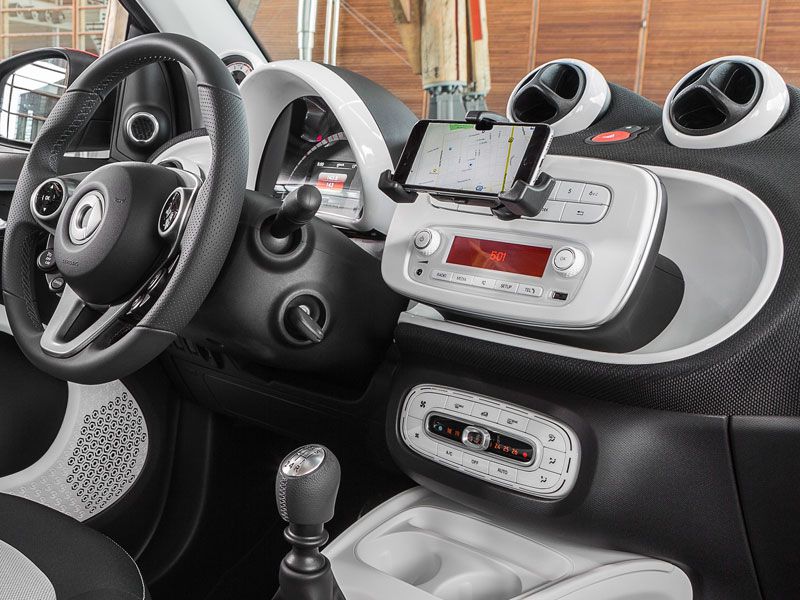
Smart ForTwo Cabrio Offers a Lot Stuffed Into a Tiny Package. But Is It Enough?
Here’s the deal: both the Smart ForTwo Coupe and Cabrio are tiny cars, there’s no way around that. But if you live in a place where compactness is an advantage—say New York, San Francisco, Boston, Washington D.C., Chicago, Seattle, parts of Los Angeles, etc—then the Smart offers a ton of premium features in a unique package. Yes there’s no back seat, so this is clearly a vehicle aimed at single living. But if you spend 90-percent of your time parking and commuting in the inner-city, then it’s worth looking at. Or even better yet, if you want an affordable convertible as a second car, Smart has done enough to improve its Cabrio that it is a compelling option. Considering its German engineering pedigree and exceptional Mercedes-Benz backed safety, there’s a lot here to like.
